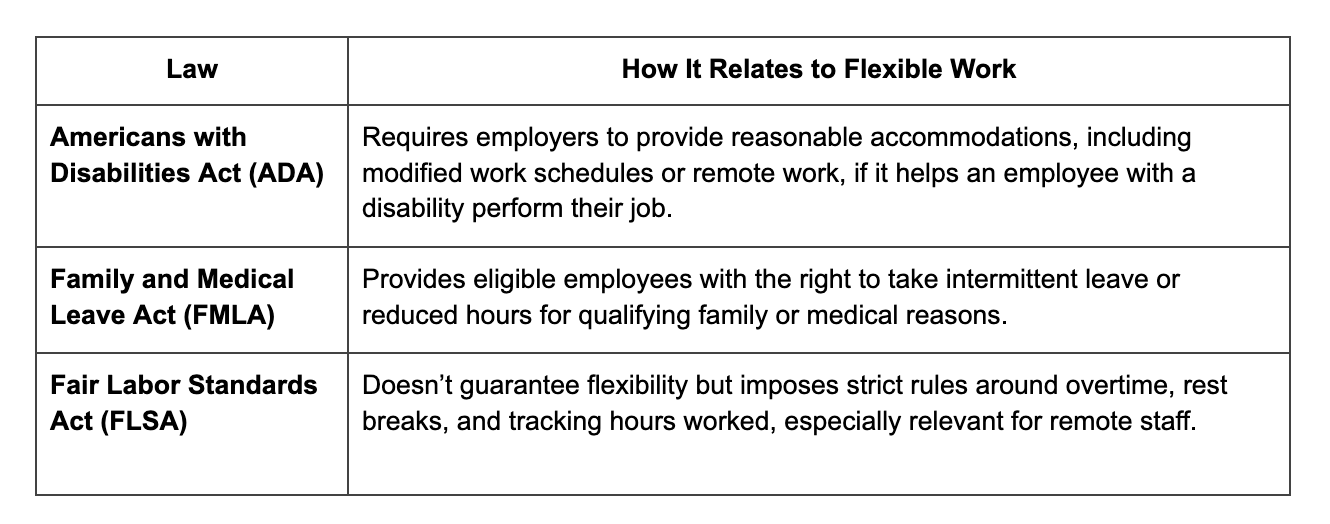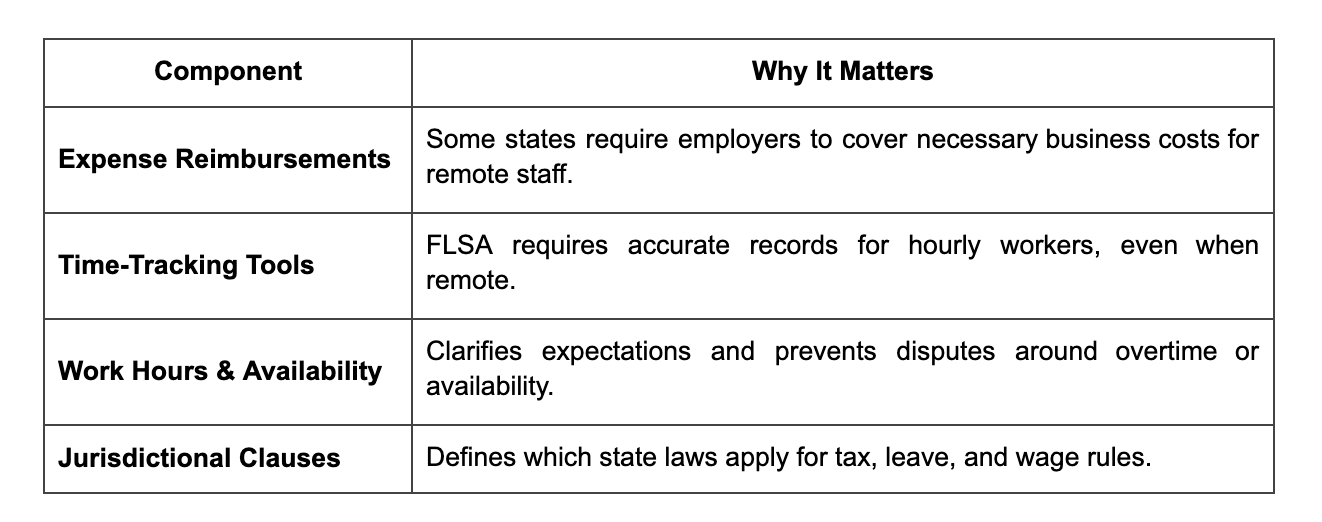A Guide to US Flexible Working Laws: What Employers Need to Know (2025)
Flexible working in the United States includes a broad range of arrangements,telework, hybrid schedules, compressed workweeks, flextime, and more. Unlike many other jurisdictions, there is no single federal statute that guarantees employees the right to request flexible working. Instead, US compliance is a patchwork: shaped by state legislation, federal laws like the ADA or FMLA, and local ordinances in places like California, New York, and Washington, D.C.
This guide helps US employers navigate remote and flexible work laws in 2025,across both federal and state levels. From understanding which states require written telework agreements, to ensuring reasonable accommodations under the ADA, compliance today means knowing your geography as much as your workforce.
What follows is a practical breakdown for HR, operations, and legal teams managing flexible work across US jurisdictions. You'll find legal insights, state-level nuances, compliance checklists, and best-practice recommendations to reduce litigation risk, whether you're a startup in Texas or a distributed enterprise based in New York.
For a global comparison, see Flexible Working Law Explained: Employer Duties & Employee Rights (2025 Guide).
Is There a Federal Flexible Working Law in the US?
As of 2025, there is no federal law in the United States that grants employees a blanket right to request flexible working arrangements such as remote work, hybrid schedules, or compressed hours. Instead, the legal landscape is fragmented, with rights and obligations shaped by indirect protections under existing federal statutes, and supplemented by state and local legislation.
Relevant Federal Laws (Indirect but Impactful)

Key Point:
While there is no standalone federal flexible work law, employers must stay compliant with overlapping obligations when handling flexible arrangements.
Employers should treat flexible working as a compliance risk area, especially if denying accommodations without justification. Inconsistent or undocumented refusals may expose companies to claims of disability discrimination, wage violations, or retaliation under these statutes.
State-Level Differences Employers Must Know
Unlike the UK or EU, the United States does not offer a single legal framework for flexible working. Instead, state and local laws determine whether remote work arrangements come with reimbursement rights, written agreement requirements, or employee protections. For employers operating across multiple jurisdictions, this creates a compliance burden, policies must be reviewed through the lens of where the employee works, not just where the business is headquartered.
Common State-Level Legal Themes
Remote Work Expense Reimbursement
States like California and Illinois require employers to reimburse remote workers for “necessary business expenses.” This can include internet, phone use, or equipment. Failing to do so can trigger wage claims under state labor codes.
Written Telework Agreements
Illinois law now encourages employers to establish formal written telework agreements outlining expectations, work hours, and reimbursement terms. While not all states mandate this, written documentation is increasingly treated as a best practice.
Employee Protection Bills
New York City’s proposed “Right to Disconnect” law would prohibit employers from requiring after-hours communication, barring emergencies. Similar proposals have appeared in Massachusetts and California, reflecting a shift toward worker protection in flexible environments.
Wage, Overtime, and Pay Transparency
Remote workers remain covered by state-level wage and hour laws. Some states (e.g., Colorado, New York) also require pay transparency in job postings, including for remote roles.

Employers should review employment contracts, reimbursement policies, and job ad language to ensure state-by-state compliance, especially if managing a distributed or hybrid team.
Building a Legally Compliant Remote Work Policy
In the US, a written remote work policy is not just best practice, it’s essential. Without a federal law standardising flexible work rights, employers must navigate overlapping federal, state, and sometimes city-specific laws. A well-structured policy reduces the risk of wage and hour violations, employment misclassification, and jurisdictional tax issues.
Why it Matters
Inconsistent handling of remote work can lead to legal exposure, especially for multi-state employers. States like California, Illinois, and Massachusetts have distinct requirements around expense reimbursement, employee classification, and time tracking. Without a unified policy, individual managers may improvise, creating gaps in compliance.
What to Include in Your Policy

Your policy should also outline eligibility, equipment standards, cybersecurity practices, and expectations around communication and performance.
If you manage employees in multiple states, we strongly recommend consulting legal counsel to ensure your policy aligns with both state and federal rules. Even one overlooked clause can result in claims for unpaid wages, denied reimbursements, or regulatory penalties.
Hybrid vs Flexible Working: What’s the Difference in the US?
In legal and HR terms, hybrid and flexible working are not the same. US employers must define them clearly in internal policies and contracts to stay compliant, especially when managing time tracking, tax rules, and wage laws.
Definitions
- Hybrid working: A fixed pattern combining remote and in-office work (e.g. 3 days on-site, 2 days remote).
- Flexible working: Any non-standard schedule, including flextime, compressed hours, or location independence.
Hybrid working is about where employees work. Flexible working is about when and how they work.
Compliance Implications (2025)
There are a few risk areas that it's important to watch:
- FLSA (Wage & Hour Laws): Time-tracking is still required for hourly staff. Flexible hours don’t remove this.
- IRS Scrutiny: Remote or multi-state staff may trigger nexus, payroll tax, and reimbursement issues.
- Misclassification: Flexible arrangements must not obscure exempt vs. non-exempt status.
Best Practice
- Define both models in your remote/flex policy
- Apply consistent timekeeping tools across all roles
- Ensure managers know how to monitor hours for non-exempt remote workers
This clarity protects both the employee’s rights and the business’s legal position.
What Happens if You Get It Wrong?
When flexible work isn’t managed correctly, legal risks follow. In the US, where there’s no universal right to flexible work, missteps still carry real consequences, especially under existing federal and state laws.

Even without a national flexible work law, how you handle requests matters. Poorly documented denials, inconsistencies across teams, or a lack of clear policies all increase exposure.
Key point: Flexibility doesn’t mean looseness. Employers must apply structure, especially when employees are dispersed.
If you're unsure whether your current setup is compliant across jurisdictions, now’s the time to review it. I help companies prevent the kinds of missteps above, before they escalate. Contact me if you’d like to assess your risk exposure.
Best Practice Tips for HR Teams
Legal compliance starts with consistency. Whether your team is remote-first or hybrid by exception, HR needs clear protocols, especially when navigating state-by-state differences.
Start with these essentials:
- Standardise onboarding for remote and hybrid hires, including tax forms, data security, and telework policies.
- Train line managers on compliance risks tied to multi-jurisdiction work. A verbal “OK” in California could breach wage law in New York.
- Track actual work locations, not just hiring addresses, this affects tax, benefits, and legal jurisdiction.
- Document every arrangement. Whether informal or formal, agreements should be written, signed, and dated. Avoid vague verbal deals.
Quick Wins for HR Teams
- Use location-specific policy addendums (Tailors legal coverage to state laws)
- Standardise telework agreement forms (Reduces legal ambiguity)
- Build a remote audit trail (Supports wage/hour and tax compliance)
- Automate work location reporting (Helps flag jurisdictional risks in real time)
- Conduct quarterly policy reviews (Keeps you aligned with legislative changes)
Building a US-compliant HR foundation isn’t about guesswork, it’s about structure. If you're unsure where your blind spots are, get in touch to avoid costly missteps.
What US Employers Must Prioritize in 2025
There may not be a single federal law for flexible working but that doesn’t mean there’s no risk. From ADA accommodations to state-level reimbursement and tax rules, compliance in the US depends on knowing where your employees work and what laws apply. The most common issues I see? Inconsistent policies, missing documentation, and managers improvising across jurisdictions.
If you're managing a distributed or hybrid team and not 100% sure your process holds up, I can help. I work with US-based companies to review policies, identify compliance gaps, and train teams to handle flexible work the right way. Reach out directly if you'd like support tailored to your team.

.jpg)

.jpg)








